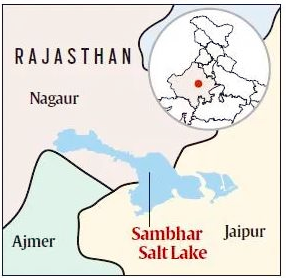Sambhar Lake: Rajasthan | 20 Feb 2021
Why in News
The State Government of Rajasthan will identify new tourist points at Sambhar Salt Lake.
- The Lake forms part of the desert circuit in the Centre’s Swadesh Darshan Scheme. The Scheme was launched by the Ministry of Tourism in 2014 -15 for integrated development of theme based tourist circuits in the country.
Key Points
- Location:

- Situated about 80 km southwest of Jaipur, in east-central Rajasthan.
- Features:
- Salt Lake: It is the largest inland salt lake in India. It represents the depression of the Aravalli Range.
- The lake’s salt supply was worked by the Mughal dynasty (1526–1857) and it was later owned jointly by the Jaipur and Jodhpur princely states.
- Ramsar Site: It is a wetland of ‘international importance’ under the Ramsar Convention, declared in 1990.
- Size and Depth:
- The area occupied by this lake differs from season to season, so roughly it is between 190 and 230 sq km.
- Also, being an extensive saline wetland, the depth of the lake also fluctuates from season to season. During peak summers (dry time), the depth measures as low as 60 cm but during the monsoons, it goes up to 3 m.
- Rivers: It receives water from six rivers, namely Samaod, Khari, Mantha, Khandela, Medtha, and Roopangarh.
- Vegetation: The vegetation present in the catchment area is mostly xerophytic type.
- Xerophyte is a plant adapted for growth under dry conditions.
- Fauna: Flamingoes, pelicans and the waterfowls are commonly sighted at the Sambhar Lake.
- In 2019, almost 22,000 migratory birds died at the Lake due to avian botulism, a neuromuscular illness.
- Before 2020’s winter season, the Rajasthan government decided to build temporary shelters for migratory birds near the Lake.
- Production of Salt: It is known for the production of brine/salt and also houses one of the largest salt manufacturing units in the country.
- Other Nearby Places: Shakambari Devi temple, Sambhar Wildlife Sanctuary.
- Salt Lake: It is the largest inland salt lake in India. It represents the depression of the Aravalli Range.
- Rajasthan Government’s Latest Plan:
- New tourist points for witnessing the flora and fauna and having a glimpse of salt harvesting will be identified at Lake.
- A “salt train”, which transported salt from the pans to a nearby refinery, will also be restarted.
- New destinations around the lake, including salt museum, caravan park, bicycle track and gardens, will be finalised.
- The illegal salt production in the lake will be stopped through action against unauthorised borewells and pipelines laid in the region, while encroachments on the land will be removed with the help of police.
